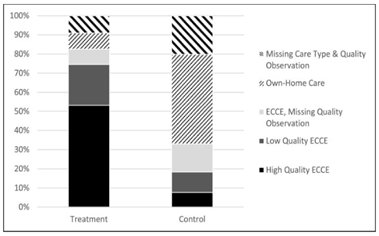Unpacking the Treatment Contrast in the Head Start Impact Study: To What Extent Does Assignment to Treatment Affect Quality of Care?
Summary by: Elizabeth Hentschel
Background
Attending high-quality early childhood care and education (ECCE) programs can lead to positive child outcomes across multiple developmental domains including cognitive and social-emotional. Children from low-income families rarely have access to high-quality ECCE – less than one quarter attend center-based childcare rated as high-quality. The National Head Start (HS) Program is one affordable (free) option to low-income families, but data from 2006 find that only 40% of National Head Start Programs are considered high quality. This study seeks to understand if children who were randomly selected and offered an opportunity to participate in Head Start enroll in higher quality ECCE than they otherwise would have.
Does the offer of Head Start services increase children’s likelihood of enrolling in high- and low-quality formal ECCE?
This study disaggregates how a random offer to enroll in HS impacts whether children enroll in any formal ECCE and the quality of the ECCE program they enroll in. As expected, offering families the opportunity for their child to join HS increases enrollment in formal ECCE by 50 percentage points (see Chart).
With respect to quality of care, 53% of children who receive an offer to attend HS enroll in high-quality HS compared to 8% of children in the control group. Among children with an observed quality score, 71% of those offered a slot in HS enrolled in high-quality ECCE compared to only 42% of those who were not offered a slot in HS. These findings are the first step in demonstrating that Head Start has the potential to improve students from low-income families' quality of care and, ultimately, their development and life-trajectory.
How the authors conducted this study
The authors utilized data from the nationally representative Head Start Impact Study, a randomized experiment in which families on the waitlist for the HS Program were randomly assigned to either receive an offer to attend HS or not. In total, 4,440 3- and 4- year old children were randomly assigned from 351 HS Centers. In the Spring of 2003, data collectors visited each child’s childcare setting (including center-based and family childcare) and assessed the quality of the childcare. These assessments were not conducted, however, for children who received care at home. The authors disentangled the impact of random assignment to HS on enrollment in ECCE and the quality of that ECCE. The authors recognize that quality was only assessed for children enrolled in formal ECCE. Therefore, the impact of HS enrollment on ECCE quality could be biased without accounting for enrollment in ECCE. The model they used allowed the authors to model the impact of random assignment to HS on enrollment and quality simultaneously. These findings are novel in the ability to isolate quality of care from higher rates of enrollment.

How to read this chart: This chart shows the percentage of children enrolled in formal ECCE with various ratings for two groups: the treatment group includes children from families offered a spot in HS; the control group includes children from families not offered a spot in HS.
Full Article Citation:
Friedman-Krauss, A.H., Connors, M.C., Morris, P.A. (2016). Unpacking the Treatment Contrast in the Head Start Impact Study: To What Extent Does Assignment to Treatment Affect Quality of Care?. Journal of Research on Educational Effectiveness, 10(1), pp. 68-95, DOI: 10.1080/19345747.2016.1147627.
